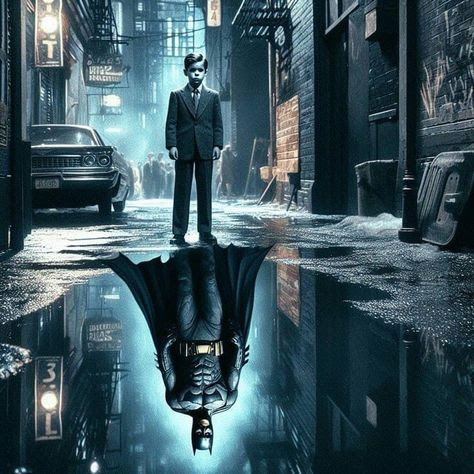The Trauma of Bruce Wayne: Beyond Fiction
ATTENTION! SENSITIVE TOPIC. Using as a backdrop the fictional piece about the trauma experienced by Bruce Wayne, the brutal loss of his parents, this post addresses Post-Traumatic Stress Disorder (PTSD).
R Cardoso

Batman, the Dark Knight, is one of the most iconic superheroes in pop culture. Created by Bob Kane and Bill Finger in 1939, the character is inspired by figures such as Zorro and Sherlock Holmes.
After witnessing the murder of his parents as a child, Bruce Wayne vowed to avenge his parents and fight crime in Gotham City. With rigorous physical and mental training, he transformed into Batman, a masked vigilante who uses his intelligence, detective skills and an arsenal of gadgets to fight crime.



The Dark Knight and the Shadow of the Past


Psychology shows us that childhood traumas, like the one Bruce Wayne experienced, can have lasting consequences in adulthood. Studies show that traumatic events can trigger a series of psychological reactions, such as:
Post-traumatic stress disorder (PTSD): Characterized by flashbacks, nightmares, insomnia, and avoidance of situations that remind one of the trauma.
Anxiety and depression: Feelings of chronic fear, anguish and sadness.
Risk behaviors: Seeking adrenaline and dangerous activities as a way of dealing with trauma.
Social isolation: Difficulty establishing and maintaining relationships.
The story of Bruce Wayne, Batman, is marked by a profound trauma: the brutal death of his parents. This event, which unfolds in his childhood, irreversibly shapes his personality and directs him towards a path of revenge and justice. But to what extent is Bruce's experience just fiction?

The importance of psychological support
It is essential to emphasize that dealing with trauma requires professional support. Therapy can help people process their feelings, develop coping strategies, and build a healthier and more meaningful life.
In summary:
The fictional story of Bruce Wayne shows us how childhood trauma can shape a person's life and the importance of seeking help to overcome difficulties and purpose, even in the face of adversity.
Bruce Wayne’s journey to become Batman can be seen as a way of dealing with his trauma. By donning the cape and mask, he creates a secret identity that allows him to face his fears and seek justice. However, this quest for revenge also isolates him and makes him a solitary figure.
Bruce Wayne’s story, although fictional, is echoed in many real-life stories of people who have overcome profound trauma. High-performance athletes, social activists, and business leaders are examples of individuals who have turned their painful experiences into driving forces to achieve great things.


Bruce Wayne and PTSD
Trauma in Real Life

The Lasting Effect of Trauma: Understanding PTSD
Post-traumatic stress disorder (PTSD) is a complex and individual response to traumatic events, such as accidents, assaults, natural disasters or war. Although PTSD is commonly associated with high-impact events, any experience that threatens life or physical or psychological integrity can trigger the disorder.
What is PTSD?
PTSD is a mental condition characterized by a set of symptoms that can appear weeks, months or even years after the traumatic event. These symptoms can be divided into four main categories:
Intrusion: Intrusive thoughts, memories, or nightmares about the trauma. Avoidance: Efforts to avoid places, people, or situations that remind you of the trauma. Changes in mood and cognition: Feelings of guilt, shame, fear, anger, hopelessness, and difficulty concentrating. Increased arousal: Difficulty sleeping, irritability, difficulty concentrating, hypervigilance, and exaggerated physical reactions. Causes of PTSD The primary cause of PTSD is exposure to a traumatic event. However, how each individual reacts to trauma varies depending on several factors, such as: Nature of the trauma: The severity and duration of the traumatic event. Personal history: Previous experiences, social support, and personality traits. Biological factors: Genes and nervous system function. Treatment of PTSD Treatment for PTSD usually involves a combination of therapies and, in some cases, medications. The most common therapies include:
Cognitive behavioral therapy (CBT): Helps identify and modify negative thoughts and behaviors related to the trauma.
Exposure therapy: Gradual, controlled exposure to anxiety-provoking stimuli.
PTSD is a complex condition that can affect the lives of millions of people. However, with proper treatment and support from family and friends, it is possible to overcome the trauma and build a happier, healthier life.

https://www.einstein.br/doencas-sintomas/transtorno-do-estresse-pos-traumatico-tept
Ministério da Saúde: https://www.gov.br/sa
Associação Brasileira de Psiquiatria: https://www.abp.org.br/
Lembre-se: Você não está sozinho.
If you or someone you know is experiencing trauma, do not hesitate to seek help from a psychologist.
For more information, see:


Attention!
The central theme of this post is to inform about PTSD, using the fictional character "Batman" as a backdrop. In no way should it be considered a valid example in the real world.
HUMANAUTAS
Science, Technology, Curiosities and Behavior.
Contact
humanautaspontocom@gmail.com
© 2024. All rights reserved.
